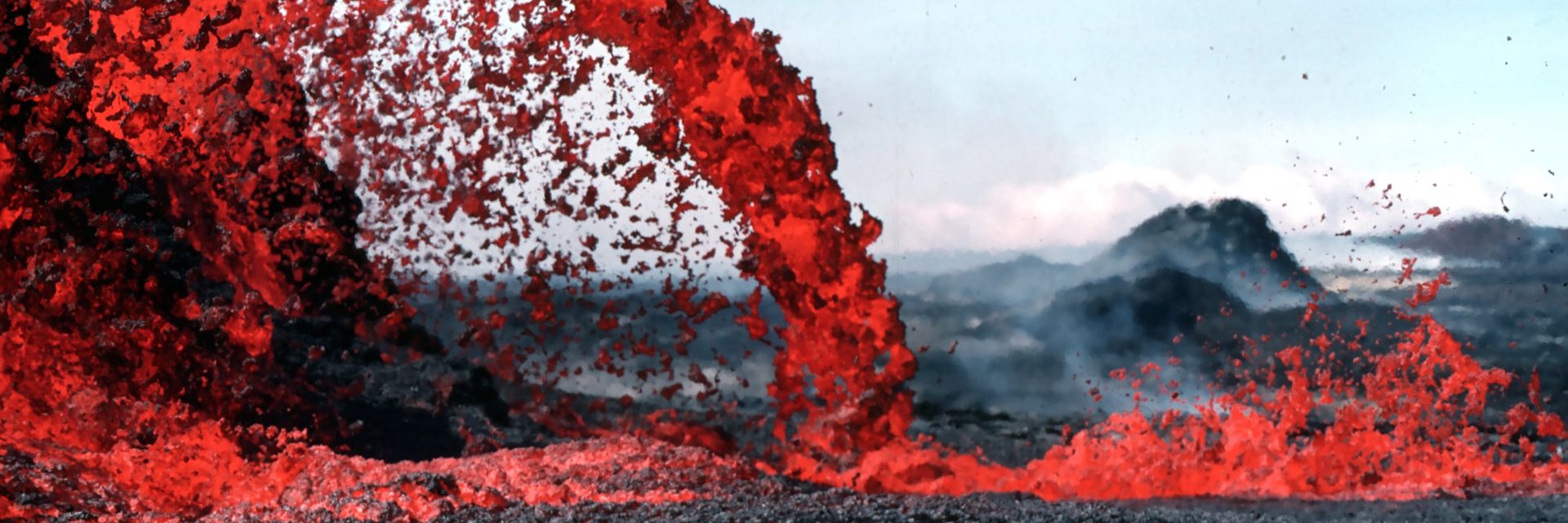The shield volcano gets its name from its summit being largely flat and tilted, with a raised section in the center, appearing to some as a warrior’s shield. There are shield volcanoes in several parts of the world, including Iceland and the Galápagos Islands, but the largest and most massive of all shield volcanoes actually form the archipelago of Hawai‘i. Come on a thrill ride that starts deep beneath the Earth’s surface to see the unique way shield volcanoes erupt.
◊
Volcanology, the scientific study of volcanoes, defines three types of volcanoes on Earth: cinder cone, stratovolcano, and shield. Two of them (cinder cone and stratovolcano) have similar characeristics.
A cinder cone volcano has steep walls and violent eruptions of lava, as well as pyroclastic material that is thrown into the air and adds to the cinder cone’s rocky, jagged appearance.
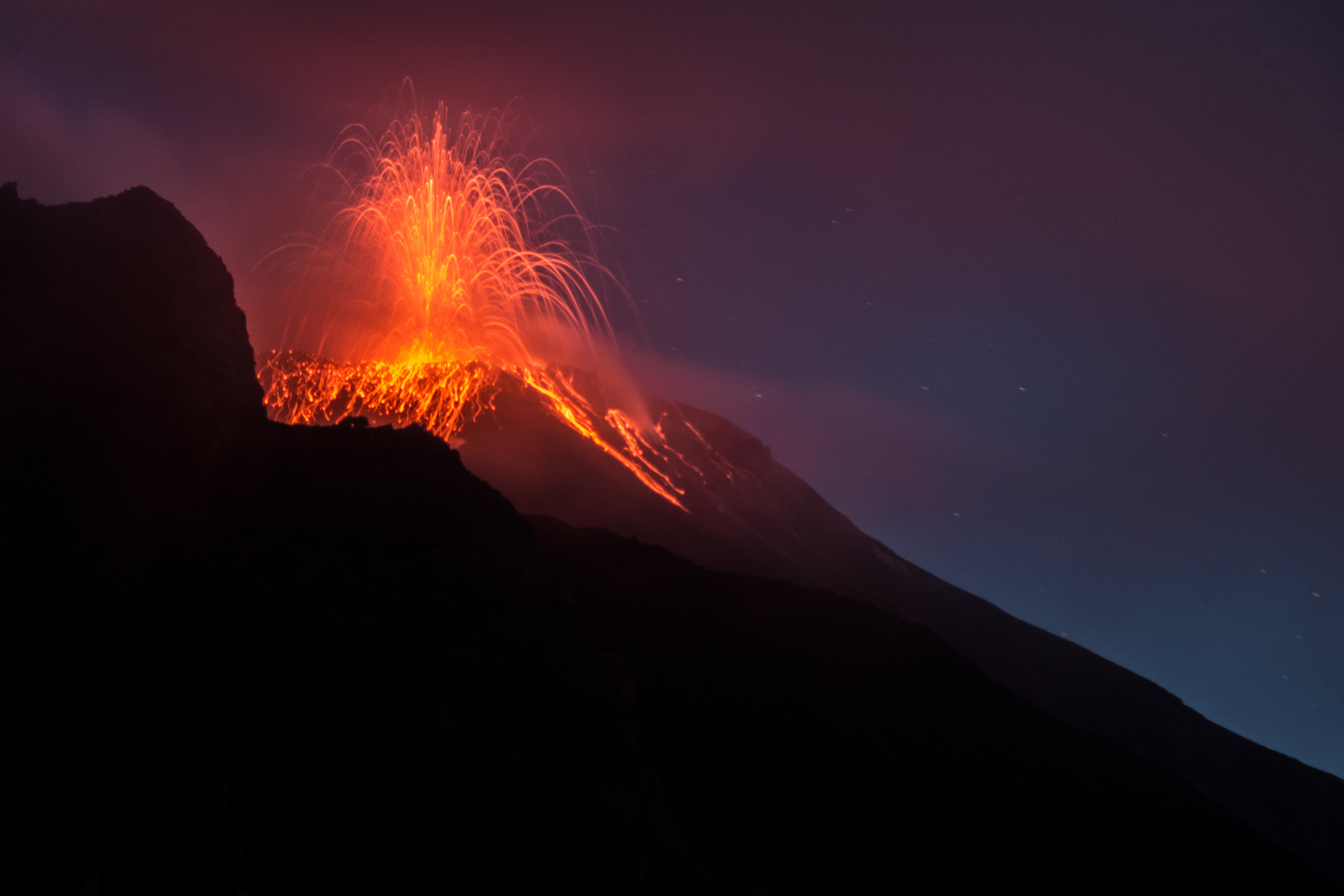
(Image courtesy of Adobe Stock)
Stratovolcanoes, also called composites, are like cinder cone volcanoes on steroids – they are taller, steeper, and more dangerous than other types of volcanoes due to the release of toxic gases. Many of the most iconic volcanoes in the world are stratovolcanoes, including Mount St. Helens in the U.S., Mount Fuji in Japan, Mount Kilimanjaro in Tanzania, and Italy’s notoriously destructive Mount Vesuvius.
Fact 1: Cinder cones get their name from their characteristic cone-like shape, which is formed by volcanic ash and cinders. Stratovolcanoes are made up of alternating layers – or strata – of compressed rock, volcanic ash, large stones and boulders, and hardened lava flow.
How Do Shield Volcanoes Form?
Would you like to take a trip on the lava train, traveling from below the earth straight up 30,000 feet or more, then spreading out down the surface of a shield volcano? Let’s go on this impossible journey at 2,500 degrees Fahrenheit. Hot stuff!
We start deep below the bottom of the ocean. Magma is created with the melting of underground rock, formed of basalt in the vast furnace of the mantle. Pockets of superheated magma well up from beneath the crust, causing the floor of the ocean to bulge upward.
Fact 2: Basalt, a lightweight porous rock in its solid form, is the primary compound forming the volcanic flow of a shield volcano. Because of its relative lightness and low viscosity, it flows quickly.
The swift upward movement of the magma weakens the stretched terrain under its bulge, eventually creating cracks or fissures through which magma breaks, eventually forming a vent. At the point that magma erupts, it’s called lava.
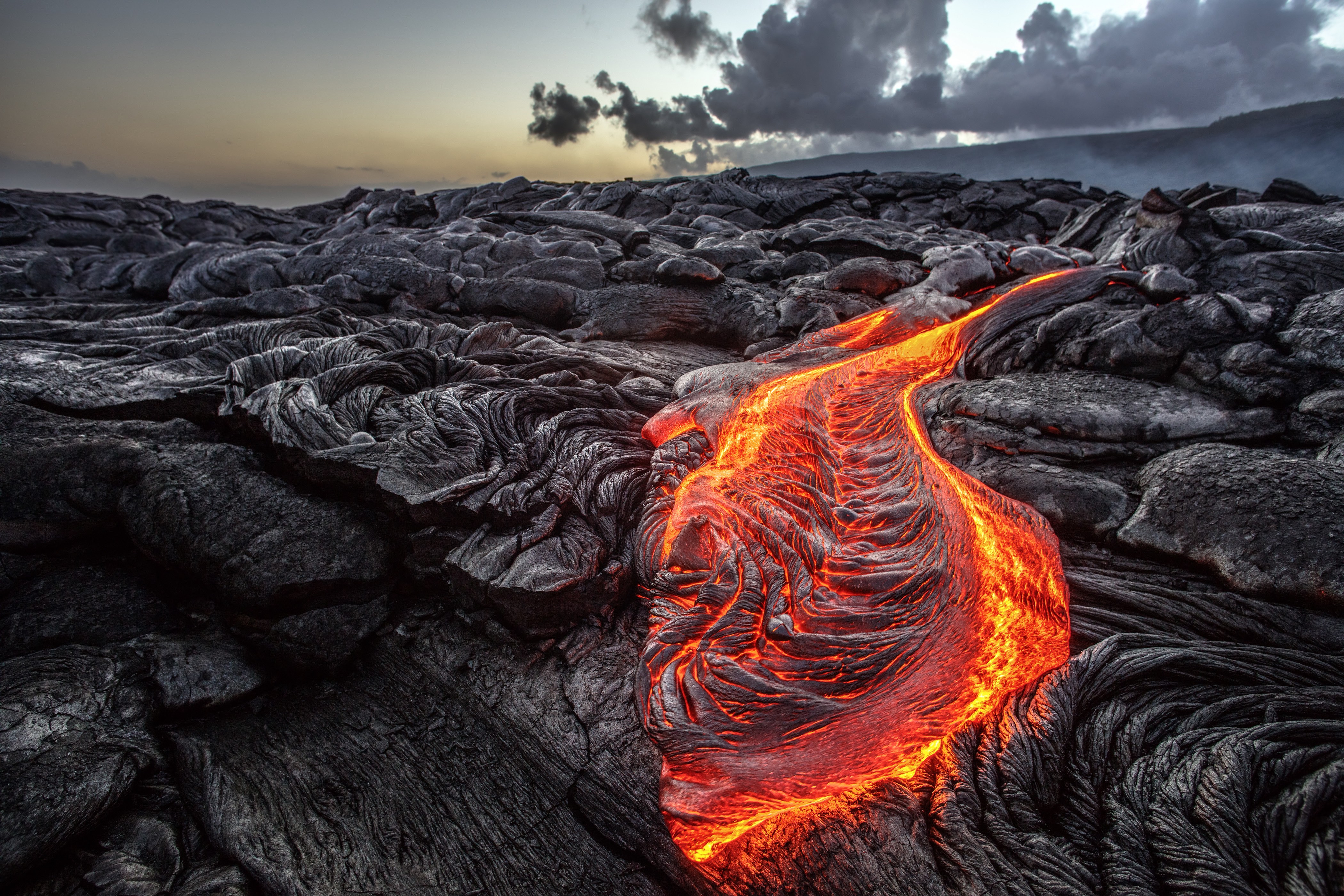
(Image courtesy of Adobe Stock)
Since this is all happening undersea, the weight and pressure of the water keep the heavier mass of the lava close to the seafloor. Runny lava flows out of the fissures under water, cooling and hardening quickly. Consecutive releases of flowing lava form layers upon which a mountain begins to form.
Over hundreds of thousands of years, the accumulation of layers of hardened lava causes the mountain to rise, and eventually it will emerge from the sea under which it lies and become a volcanic island. Basaltic lava runs above the ocean’s surface, causing the acreage of the island to grow quickly, building low, sloped mountains.
Fact 3: The shape of a shield volcano is very wide compared to its height. It is common for the base of a shield volcano to be 20 times its height.
Over the long life of an active shield volcano, so much lava is pushed out that it forms fields where lava flows horizontally in all directions. This is when lava tubes are created, carrying large volumes of lava far across the new landscape and depositing the hot liquid mass far away, adding to the size of the volcano’s footprint.
.jpg)
Nyamulagira volcano (Image courtesy of MONUSCO Photos, via Wikimedia)
Feel the need to get up close and personal with an active volcano? Join Volcano Hunters for one of their adventures.
Shield Volcano Eruptions
Shield volcanoes pop up in various spots around the world, and have distinctive features wherever they appear.
In Iceland, for example, there are numerous shield volcanoes clustered in two regions of the island. The volcanoes there are relatively smaller and more closely grouped than shield volcanoes elsewhere. In the Galápagos Islands, several but not all of the islands have been formed by shield volcano eruptions. The shield volcanoes of the Galápagos are among the youngest chains of volcanic islands. And the shield volcanoes that formed Hawai‘i, which are among the oldest, are legendarily large: tall, wide, and voluminous.
Fact 4: There are volcanoes on other planets, and many of them, such as ones discovered on Mars, Venus, and Jupiter’s moon, Io, are shield volcanoes. Low gravity is a factor in lower eruptive activity and symmetrical lava flows.
Another way shield volcanoes differ from other volcano types is the distinctive way that they erupt. Although we use the world erupt to describe the flow of lava from the top of a volcano, it’s not precisely descriptive of how lava is released from a shield volcano. As opposed to the violent, shattering type of explosions that cinder cap and stratovolcanoes display, in shield volcanoes the flow is effusive, not explosive. The release is more of a push than a pop!
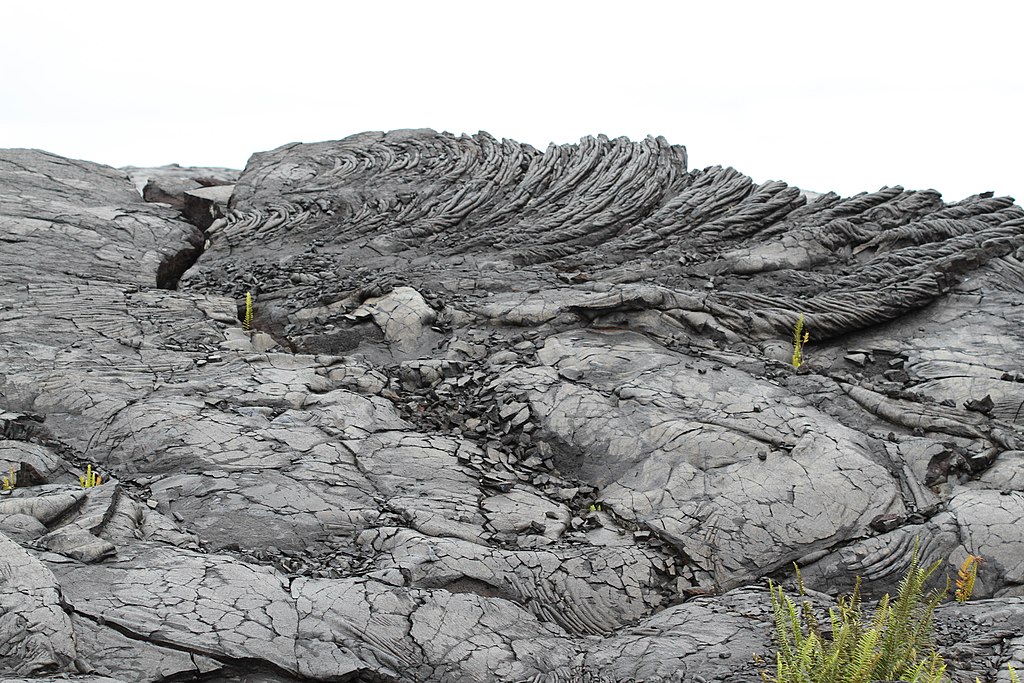
(Image courtesy of Ryan Lackey, via Wikimedia)
One more distinctive characteristic of shield volcanoes is that lava flows not only up through the summit but also through a network of fractures in the structure. Because of this, eruptions of such volcanoes differ from the cartoonish image most of us carry in our minds, perhaps from watching a few too many episodes of The Flintstones.
When lava flows from a shield volcano, it moves more quickly than other types of lava because of its viscosity. This refers to the “thickness,” or heaviness, of the liquified substance. Since there is little rock in the shield lava flow, as compared with other volcano types, it moves at a faster rate, which is caused by its low viscosity.
This relatively fast flow of volcanic ash and lava can cause a lava tube to form, which permits the volcano’s lava to flow even faster, unimpeded, along the easiest downward direction. The ejected material just pushes in every direction, with gravity pulling it down until it pools at its lowest altitude. This process adds to the shape and size of the volcano and, if it is surrounded by water (as in Hawai’i), new and habitable land is formed.
Fact 5: A shield volcano’s lava tubes are cave-like structures formed by hardening lava. Lava forms an insulating layer that allows the hot lava to flow fast and far from the center of the volcano.
Hawaiian Shield Volcanoes’ Amazing Facts
Because shield volcanoes are not explosive, volcanologists sometimes refer to them as “gentle giants.” That’s apt, because, though not especially violent, shield volcanoes produce enormous amounts of lava over long periods of time. And the world’s largest shield volcanoes are all in Hawai‘i.
In fact, there would be no Hawai‘i without shield volcanoes, as their serial appearance along the Hawaiian archipelago literally created its islands. For example, Mauna Loa, a shield volcano located on the “Big Island” of Hawai‘i, is the world’s largest active volcano. The fabled volcano accounts for more than 50 percent of the surface of the Big Island.
Most commonly, shield volcanoes form during a single long-term eruption that can last decades, centuries, millennia, or more. For example, Mauna Loa has been active for 700,000 years, though its most recent eruption began in 1984.
Fact 6: A vast magma chamber underneath the center of a shield volcano releases its viscous material through a conduit called a dike, a vein-like structure that allows lava to be pushed upward through other material and be released at the summit.
Incidentally, the world’s tallest mountain is not Mount Everest – it’s a shield volcano, Mauna Kea, in Hawai‘i. It achieves this record not by its height above sea level, which is only about 14,000 feet, but by the enormous height of its underwater portion. There’s nearly another 20,000 feet of the mountain underwater, putting the total height of the mountain about one mile taller than Everest.
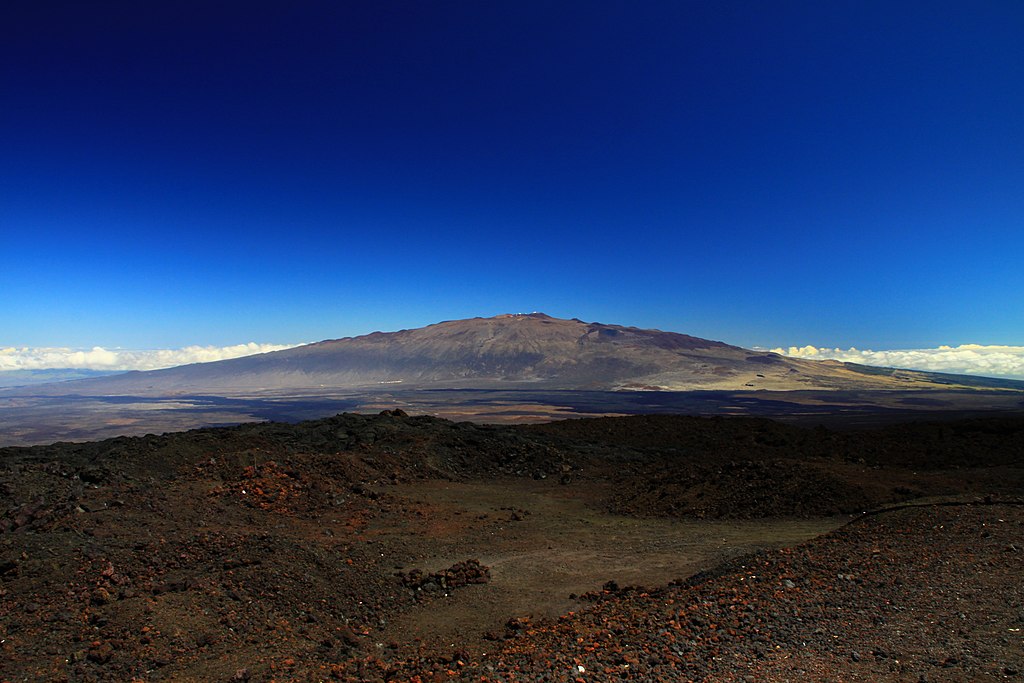
Mauna Kea from Mauna Loa observatory, Island of Hawai?i
(Image courtesy of Nula666, via Wikimedia)
Shield Volcanoes and Seamounts: The Birth of Lo‘ihi Seamount
Volcanoes can be among the oldest “active” geological features on Earth. Some, like Mauna Kea, are over a million years old. And yet there are volcanoes being born today; even now, off the southwest coast of the island of Hawai‘i is an underwater plateau belonging to the state’s youngest volcano, called the Lo‘ihi seamount. Sometime within the next several thousand years, the underwater mountain is likely to break the surface, eventually forming another island or conjoining with the island of Hawai‘i.
According to Geology.com, Lo‘ihi is 10,100 feet high. But that’s a relative height – it’s all underwater! And it is definitely growing. In fact, it’s only 3,100 feet below the surface of the ocean. So, future amateur volcanologists and oceanographers will be able to explore the islands eventually created by this ongoing geological event.
The Allure of Hawai‘i’s Shield Volcanoes
As we’ve seen, shield volcanoes are but one type of volcano. But these relatively squat, wide and voluminous natural structures are unique in their own right, from the type of basaltic lava they produce to the way it’s created, through effusion rather than explosion.
Should you ever make it to Hawai‘i, or if you have the pleasure of residing or having visited there, take a look at these marvelous creatures of stone, rock, and ash. You won’t be able to ride a lava flow, but just try not to be impressed.
Ω
Kevin Martin is Senior Writer for MagellanTV. He writes on a wide variety of topics, including outer space, the fine arts, and modern history. He has had a long career as a journalist and communications specialist with both nonprofit and for-profit organizations. He resides in Glendale, California.
Title image: Pahoeoe fountain. (Credit: Jim D. Griggs, via Wikimedia Commons)
